Road & Track Performance Car of the Year 2021
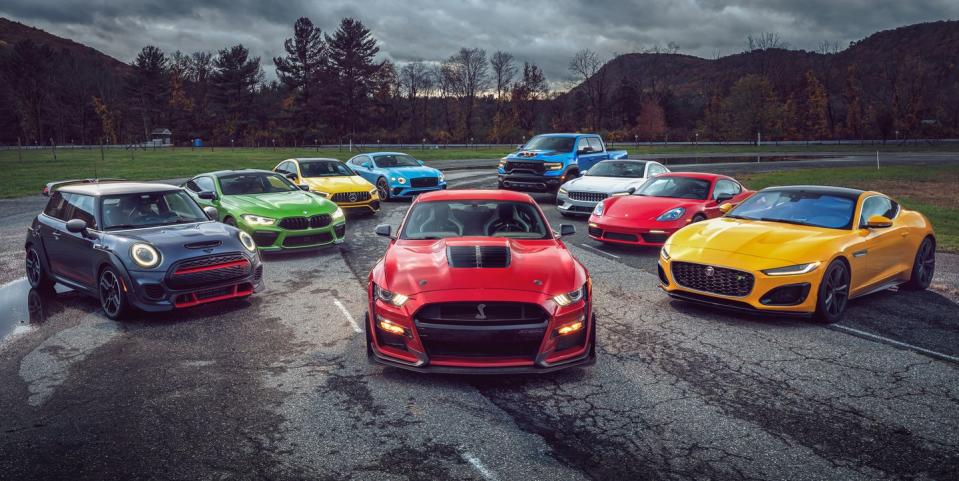
Performance Car of the Year is an event we spend months planning. We carefully select and map out the best roads; we secure a challenging race track to evaluate the cars at speed. Manufacturers send their best, most amazing new metal to compete for the crown.
This year, for our eighth running of PCOTY, we planned to go to the southeast. A fantastic road trip through the Great Smoky Mountains, topped off with track time at the fast, intricate Atlanta Motorsports Park in Dawsonville, Georgia, the home of NASCAR champs Bill and Chase Elliott. The field of cars we invited was as diverse as it was exciting. The makings of an epic week.
Like a lot of things in 2020, it wasn’t meant to be. One week before our planned departure, an email advised all staffers at our parent company to avoid interstate travel due to increasing COVID-19 risk. A multi-day road trip through states with rising positivity rates was suddenly off the table. And so, we thought, was PCOTY.
But Road & Track is nothing if not plucky. Our annual performance-car super test needed to go on. The folks at Lime Rock Park, our favorite bullring in the Northeast, quickly stepped in with two days of track time. Manufacturers rerouted cars. Our multi-day road drive through Appalachia became a day of local loops in upstate New York. Our entire staff got COVID tests; masks were mandatory.

It was a different sort of PCOTY. Where we used to spend hours whittling down each car’s lap time, now we spent just a few laps with each car to get its measure. Days of meditating over each car’s merits in every environment became urgent, empassioned discussions that needed immediate resolution. At previous PCOTY tests, we worried about oppressive heat and humidity; this year, our meteorological concern was over cold, rain, and worryingly, even snow.
Certain invitees dropped out. The McLaren 765LT, Ferrari F8 Tributo, and Porsche 718 Cayman GT4 were no longer able to participate, victims of shipping delays or quarantine rules that prevented their arrival. Replacements, like the Porsche Cayman T and—wait for it—the Hellcat-powered Ram 1500 TRX, added diversity to the field, and spurred interesting conversation.
This is a different sort of PCOTY, but the conclusion shouldn’t be a surprise.

The Contenders
Each year, we invite the most significant performance cars that have debuted in the past 12 months to participate in this group test. That means everything from high-horsepower pony cars like the 760-hp Ford Shelby Mustang GT500 to lithe sport sedans like the Mercedes-AMG CLA45. This year also included some significant cars that weren’t able to make it to last year’s test, like the Bentley Continental GT, Polestar 1, and BMW M8.
This year, we gathered up nine cars for testing at Lime Rock Park followed by a day on the surrounding country roads. Here, in ascending order of horsepower, are the competitors:

The Track
Late October in New England is a fool’s gambit. On its best days, bright sunshine pairs with glorious foliage, leaves kicking up in your wake as light peers through newly barren limbs and comfortably crisp air wafts through open windows. A film scene brought to life.
Then there’s the other side. A sky that stays the same shade of grey from sunup to sundown. A constant breeze that’s just strong enough to turn crisp air frigid. Rain that feels like liquid ice, the kind that kills plants instead of rejuvenating them. That’s the kind of weather that welcomed us to Lime Rock Park. Thankfully, the track dried before our lapping sessions, but the skies were grey and the temperature was cold the entire time.
While Lime Rock isn’t a long track, it is likely the most challenging 1.5-mile circuit in the country. One lap gives you a full understanding of a car’s dynamic abilities. And while we ran timed laps in each car, we weren’t chasing records. Each contender was allotted a couple warm-up laps, then three to four laps at speed—enough to collect a representative lap time, but not an obsessive all-day hunt to find the absolute limit in each corner.
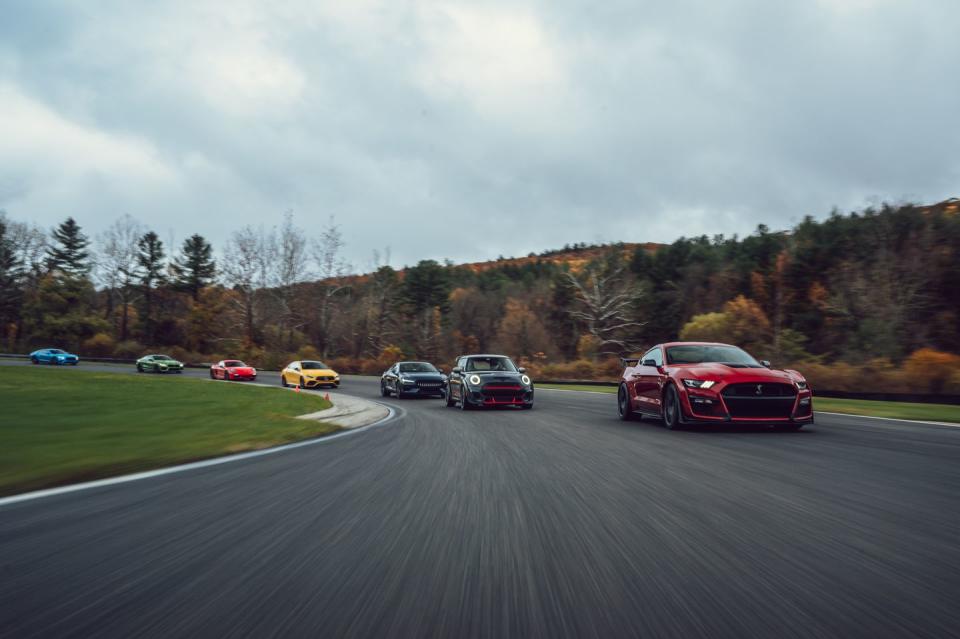
And in order to add in a little extra spice, we ran Lime Rock’s optional chicane in lieu of the fast uphill. This was partly for safety, as some of these cars would hit the uphill going fast enough to catch air. Cool to see, terrifying to experience, and a potential disaster in the waiting. We estimate this layout adds about two to three seconds to a lap time that runs the classic configuration.

The chicane added a new braking zone and a truly sharp corner to the track. The Porsche 718 Cayman T ate them up. The first car on track, it ran a 1:04.52 on its fastest timed lap. Quick, but that doesn’t tell the full story. The Porsche made lapping easy, plug and play. The overall impression was balance. Nothing felt overpowering here—even running a fast time in the car was zen-like. This was also the only car that brought three pedals to this year’s test, and thankfully, the Porsche’s shifter is exceptional, one of the finest out there. The lone complaint? The gearing is far too tall. Shorter gears would mean you shift more—the action is so satisfying, you want to be interacting with it as much as you can. The steering is also beautifully judged, wonderfully direct and accurate. Staffers agreed.

“Gorgeous balance, near perfect steering,” beamed senior reporter Chris Perkins. His notes summed up everyone’s praise, but there was one part of the car that came in for criticism: the engine.
The T has the 2.0-liter turbocharged flat-four from the base Boxster. While the numbers are great—300 hp and 280 lb-ft of torque—this isn't the flat-six calling card we’ve all come to expect, the one Porsche offers in the Cayman GTS 4.0 and GT4. While editorial director Joe Brown “wanted a little more power,” staff writer Brian Silvestro had a more scathing take, calling the engine “anemic” with “an unexciting, flat torque curve.” A common refrain with so many turbocharged cars these days.
A similar complaint was heard about the Mini Cooper John Cooper Work GP, a stripped-out version of the lovable Mini with ridiculous aero touches, no back seats, and 302 horsepower going straight to the front wheels, torque steer be damned. The Mini ran a 1:06.3 on track, about three seconds behind the lap time we clocked on the traditional track layout in warmer conditions earlier this year.
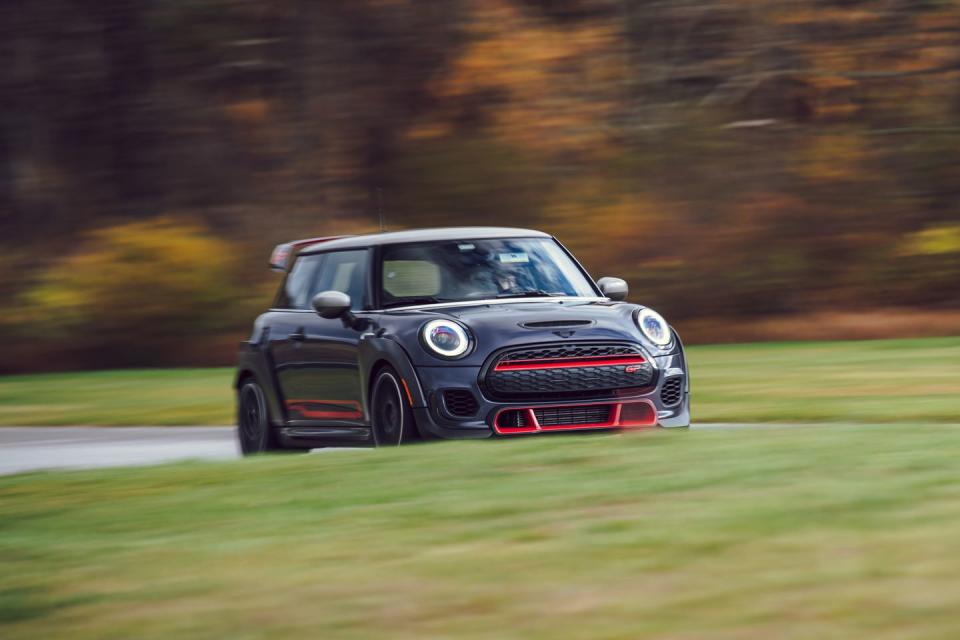
It’s still an animal, a rowdy bulldog that needs you to take charge and actually control the torque steer. It’s refreshing fun, and it shows: Drivers lined up for a chance in the Mini, their notebooks full of praise. Associate editor Mack Hogan said it “feels like the simple flickable hatch you want” while Silvestro called it “fun to muscle around.”
[Note: Due to an equipment malfunction, we were not able to record video of the Mini's lap.]
But there are issues. The engine, a 2.0-liter turbo four sourced from BMW, is characterless, the power dropping off about 1000 rpm before redline. And when left to its own devices, the gearbox, as contributor Dave Burnett put it, is “as dumb as a bag of hair.” But leave it in manual and short-shift it on acceleration, and there’s plenty of thrust.

It was a similar procedure with the Mercedes-AMG CLA45, the brand’s smallest sedan paired with the world’s most powerful production four-cylinder. With 382 hp and 354 lb-ft, we expected the little Merc to be quick. And this one had extra-sticky rubber, Pirelli Trofeo Rs, a $2900 option we expected would make it quick on track. It was. The 1:04.55 it turned was right on par with the Cayman. But those special tires aren’t what you’d want for road use. They need aggressive swings of the wheel to come up to temp before they’ll make any grip.
The engine is a little firecracker, loud and brash, a hornet's nest waiting to be deployed. But it’s so buzzy, it can echo in your head. At times, the racket was so indiscernible, I wouldn’t notice that the car had denied me a downshift, which it will do in braking zones if you grab the paddle too early for the car’s liking. Still, the little Merc came in for its fair share of acclaim, Hogan saying that it “feels eager and incredibly sharp on turn in” and web editor Aaron Brown saying that “this where I feel most at home.” You can see why. It’s the right size. It feels refined yet brazen. It’s fast in a straight line and adjustable in a corner, with a playful tail, and has an interior that seems to be taken directly from a mid-priced European hotel. The Mercedes-AMG Ibis.
If you want to upgrade to the Ritz, though, you’ll need the Continental GT V-8. This is not a track car. Not even close. If the gorgeous leather-and-wood interior—which Silvestro said “smelled amazing”—wasn’t a hint, then the 5000-lb curb weight body-slams the point home.

Like most cars from the VW Group, the Bentley shares underpinnings with oodles of other models. This British brute is most closely related to the Porsche Panamera, right down to the 4.0-liter twin-turbo V-8 (here making 542 hp and 568 lb-ft) and the eight-speed dual clutch gearbox.
You’re prepared for it to be a wonderful long-distance cruiser. What you’re not prepared for is how much actual fun it provides on track. It runs a 1:04.92, comparable to both the Porsche and the Mercedes, but it’s more hilarious getting there. You throw it up on curbs to get it turned and just trust that the massive brakes will slow it down repeatedly every lap. The steering is numb—you rely on your other senses, not your fingertips, to tell you what the front end is doing—but the chassis is well damped and controlled, becoming more and more fun as you push it.
Perhaps the joy is in the unexpected nature of it all. While other automakers worry about stripping out weight, you’re in your living room, getting a back massage, while cutting sub-1:05 lap times. “I didn’t expect to like this car as much as I do,” noted deputy editor Bob Sorokanich. He speaks for all of us.
That sort of kindness didn’t extend to the Jaguar F-Type R, now with a new nose and 575 hp on tap. Jag has adjusted the damping and calmed the whole package down, toning down the boisterous exhaust that popped and banged and occasionally sounded broken in favor of a more subdued note. It all should add up to a fantastic package on the street.
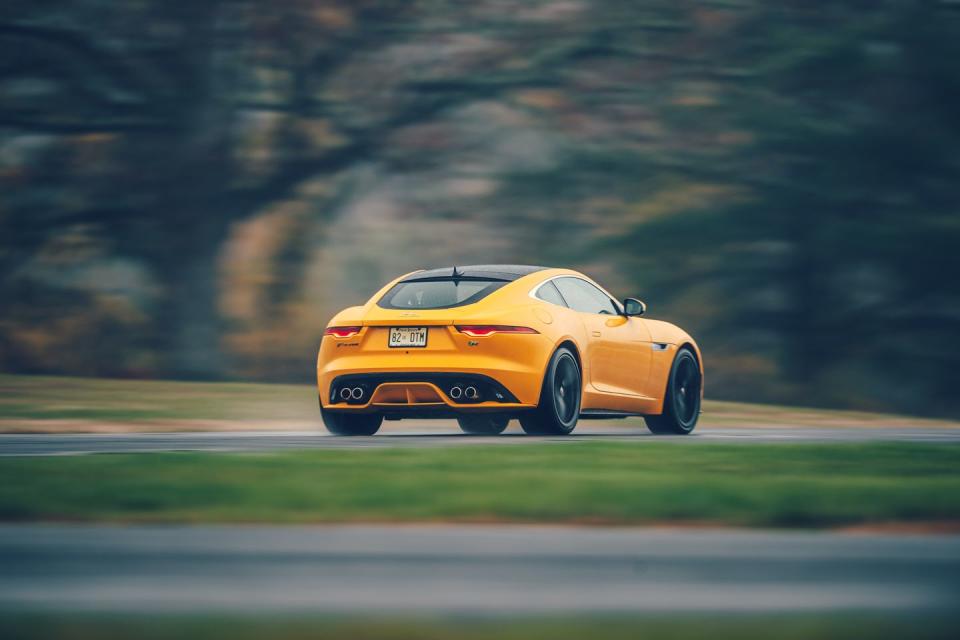
But PCOTY is predominantly a track test. While the Jag ran a 1:03.59 and was touching 140 mph on the front straight, it was easily the scariest to drive in this group. In fast right-hand corners—i.e., most of Lime Rock—the weight transfer would lift the back end and create an unstable mess, where you’re cranking the wheel to the left to keep the rear in check. As editor-in-chief Mike Guy said, “the rear end gets real light real quick. It’s fast in a straight line but nerve wracking at the limit.”
A shared sentiment, and especially disappointing because the F-Type used to be lairy on command, tossing in oversteer with a stab of the throttle—not on corner entry where you need to trust it not to bite you. That said, the engine is still a monster, as Silvestro noted, with “a fat powerband.” That supercharged 5.0-liter V-8 is matched to a gearbox that’s good and bad. The good: it’s quick and listens to your commands. The bad? The shifts are abrupt and rough, unsettling the car’s already precarious balance mid-corner. A track car this is not. Perkins summed it up with one word: “Terrifying.”
Our first plug-in hybrid PCOTY contender also isn’t meant as a track car, but it is an intriguing new take on performance. The Polestar 1 uses a turbo-and-supercharged 2.0 liter four-cylinder and an integrated electric motor to drive the front wheels plus twin electric motors on the rear axle to bring output to a wonderful 610 hp. It’s gorgeous, pure Swedish concept fantasy brought to life with huge 22-inch wheels, fat arches, and a delightful window in the trunk bulkhead that lets you look at the electric drivetrain circuitry. There’s also plenty of sporting hardware, with adjustable Ohlins shocks and Akebono brakes big enough to serve Thanksgiving dinner off of.
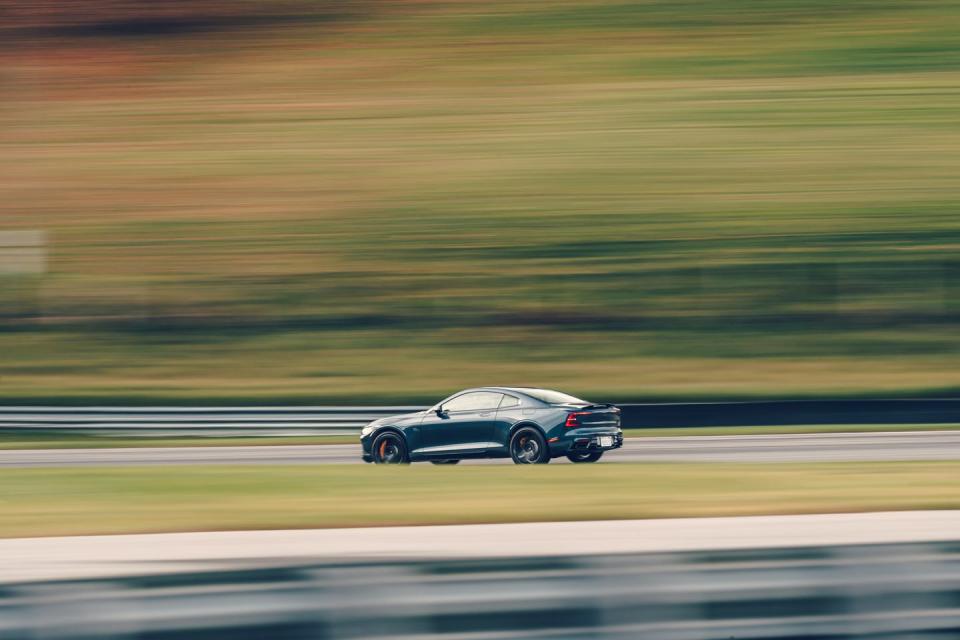
Those brakes might be the most impressive part of the car. The Polestar is heavy—nearly 5200 lbs—but its brakes feel like they could stop a semi in record time. The pedal response is sharp and immediate, and the 1 sheds speed unlike any other car here. Truly a joy. But the drivetrain calibration lets the 1 down. The Polestar’s 1:07.36 lap time is a reflection of the hybrid drive system seemingly getting confused at certain parts of the track, hesitating to put the power down or taking a second to react to throttle inputs.
The lap time doesn’t tell the full story, though, since there’s a lot of complex and interesting stuff happening here. The torque-vectoring rear axle helps the rear end rotate, and the suspension is high-end stuff that’s extremely talkative. Like the Continental GT, this is not a track car, so the steering is numb, and the whole package is clearly not tuned for lapping. It’s divisive, with some on staff calling it “interesting” and “brutally fast” and others calling it “boring” and “distant.” But a great GT car isn’t meant for everyone. It needs to appeal to a niche and go all-in. The Polestar is aimed at a certain type of buyer, one who probably won’t be chasing lap times.
Time for the M8 Competition. BMW’s flagship coupe might bring back a classic model line, but in reality, like the M6 before it, this M8 is basically an M5 with a different body. It does have all the tech, with an eight-speed automatic and more modes and settings for everything than you could possibly need. You can even disconnect the front axle to make it rear-wheel drive.

One thing is for sure: It’s bananas quick, putting down a 1:02.06 in just three hot laps, with room to go even quicker. One thing it could have used to put down speed more easily: grippier tires. The P Zeroes on here just didn’t cut it—they lost gobs of time mid-corner when g-loads got higher, and they got greasy as temps increased. But a stickier tire would sacrifice the car’s well-roundedness on the road.
The engine is a star. The M8’s 4.4 liter V-8 has 617 hp, 553 lb-ft of torque, and feels like it’s always in the power band. For an engine architecture that’s shared across so many models, it feels far more exotic than it is, a testament to the engineers in Munich. It’s paired with ZF’s 8HP automatic, a gearbox that’s nearly ubiquitous in performance cars now. BMW’s tuning of the box is outrageously good. It feels more like a dual-clutch than a conventional torque-converter transmission, with quick, smooth shifts and no lag between gears.
But while the BMW does everything objectively well on track, there’s something missing. It’s a tired refrain with modern BMWs, that they’re not what they used to be, but it still rings true. The M8 is fast, with outstanding brakes, and it can obviously obliterate a track, but it does it in a way that feels clinical. It’s without joy, like it wants to please a stopwatch more than a human. Hogan put it best: “Technically good, you just won’t be having any fun. How does this BMW make light oversteer in a 600-hp monster feel so boring?”
It could be the steering. Once a hallmark of the brand, BMW’s electric rack is overboosted and numb, keeping you distant. Sorokanich also had a gripe with the sheer amount of drive modes available: “It’s completely overwhelming and it leads you to constantly question the setting you’ve chosen. I’m left wondering who this car is for.”
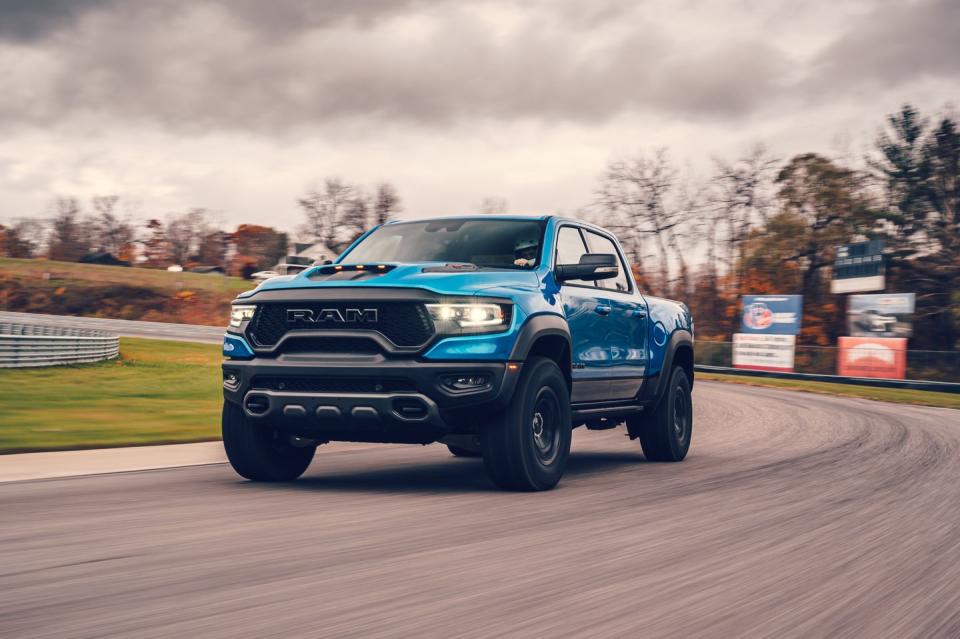
Then there’s the Ram 1500 TRX, a last minute, somewhat bewildering addition to our test. A suggestion to bring it gathered steam in the week before PCOTY, especially after hearing how it impressed our colleagues at other outlets. Also, with 702 hp from the Hellcat-sourced 6.2-liter V-8, we’d have found any excuse to drive the world’s most powerful pickup.
This is a nearly 7000-lb truck that can get to 60 in less than four seconds. On track, it’s kind of hilarious, the racing line becoming a suggestion as you grab far too much curb or throw it in the dirt to cut a chicane just because you can. It’s so tall that Silvestro said “it feels like you’re driving a building.” And while it’s nearly hitting 120 mph on the straight, it needs to take Big Bend, Lime Rock’s sweeping turn one, nearly 20 mph slower than every other vehicle in the test. Its fastest–and only–timed lap was a 1:16.78 before it lost nearly all braking on the front straight.
Of course, Ram didn’t build the TRX with repeated heavy braking from 120 in mind. It’s not meant to be on a track. It’s meant to thrash dunes and destroy trails while being mind-bendingly quick on a highway merge. While it was fun—and funny—this wasn’t its environment.

But it was the GT500’s environment. Previous iterations of the most-powerful Mustang were only suited to sprinting in a straight line, unsophisticated chassis and suspension design making them crumble when you turned the wheel. The last GT500 was just scary, flexing to a point where it felt like it was going to break in half. This newest generation has 100 more horsepower—760 in total, from a supercharged 5.2-liter V-8—but it also has a stiffer chassis, magnetorheological adaptive dampers, Michelin Pilot Sport Cup 2 tires on carbon-fiber wheels, and the first dual-clutch gearbox to ever grace the Mustang lineup. It also looks serious, low and wide with a massive splitter and an adjustable wing that isn’t just for show.
It gets you when you push the start button, the supercharged V-8 unleashing a hellacious bark and settling into an aggressive lope. Like other Mustangs, this is a big car, and at 4059 lbs, it’s one of the heaviest cars in this test despite the lightweight wheels and optional rear-seat delete.
It shrinks around you on track, feeling like a GT4 car. The suspension is firm and the steering communicative, reminiscent of BMWs of old. Power delivery is instant and ferocious, paired with that truly wonderful dual-clutch gearbox. Yes, yes, a manual would be wonderful, but this transmission is legitimately great. Unlike so many others, it’s programmed beautifully, allowing for aggressive downshifts that other dual-clutch systems might deny.
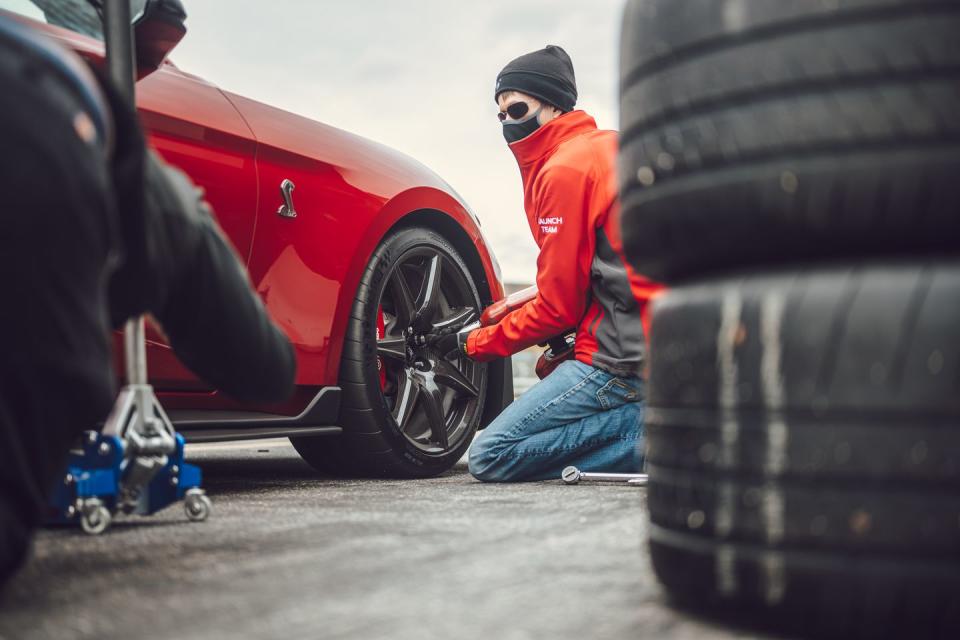
A timed run in the GT500 feels effortless, but it’s easily the quickest car at the track. That’s reflected in my time after three laps: 1:00.15, two seconds quicker than the M8. And even on my in-lap, the car told me where I could pick up more speed. It’s infuriating to get that close to a sub-minute lap and not crack it. This test isn’t about chasing an ultimate lap time, but the GT500 was the exception. It wants to be pushed harder.
There were two places I could easily gain time: under braking into Big Bend, and with a little more commitment through West Bend. I pushed the braking zone into Turn 1 a little further, nudging 150 on the short front straight before hopping hard on the firm pedal to get it stopped. This got me more speed in the Lefthander and on No Name Straight, with a massive increase in speed in West Bend, where the GT500 just hung on and asked for more. After three more laps, I pitted in. The time: 59.26. I’m convinced that with more lapping, I could have found even more time in it, but we had to move on with our test.
What’s amazing is just how friendly it is. Once the tires and brakes come up to temp, there’s no worrying about grip. None. It digs in and begs you to push it, to eke out that extra tenth. In many cars, grip like this can make a car boring below the limit. Thankfully, that’s not the case with the GT500, which came in for heavy praise from every single staffer.
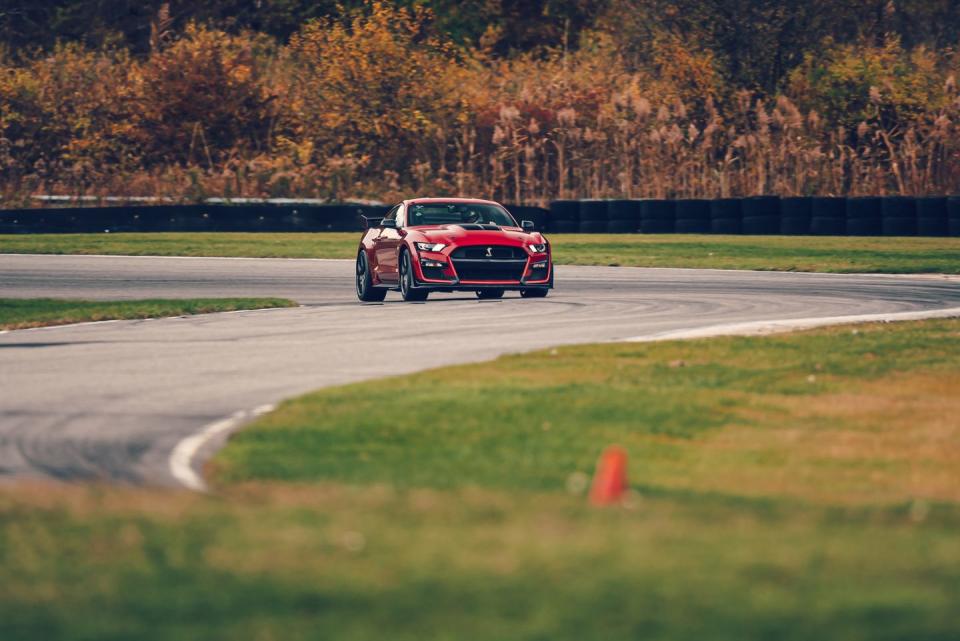
“Not scary,” said Aaron Brown. “Extremely welcoming and forgiving at all times.” Guy gave the dual-clutch transmission the highest praise possible, dubbing it “911 GT3-like” and calling the car approachable without being spooky. Joe Brown summed it up in one word: “Confidence.” Hogan was ecstatic, calling the GT500 “the coolest thing here by a long shot.”
As we left the track, it was clear that one car had made an impression above all others. While some staffers loved the Mini or the Bentley on the track, our conversations just kept returning to the Mustang, and how Ford’s engineers had made such an approachable, fun machine out of the most powerful car in this test, no matter if you were pushing it hard or just chasing laughs. The big question was whether that track prowess would hold up on the road.

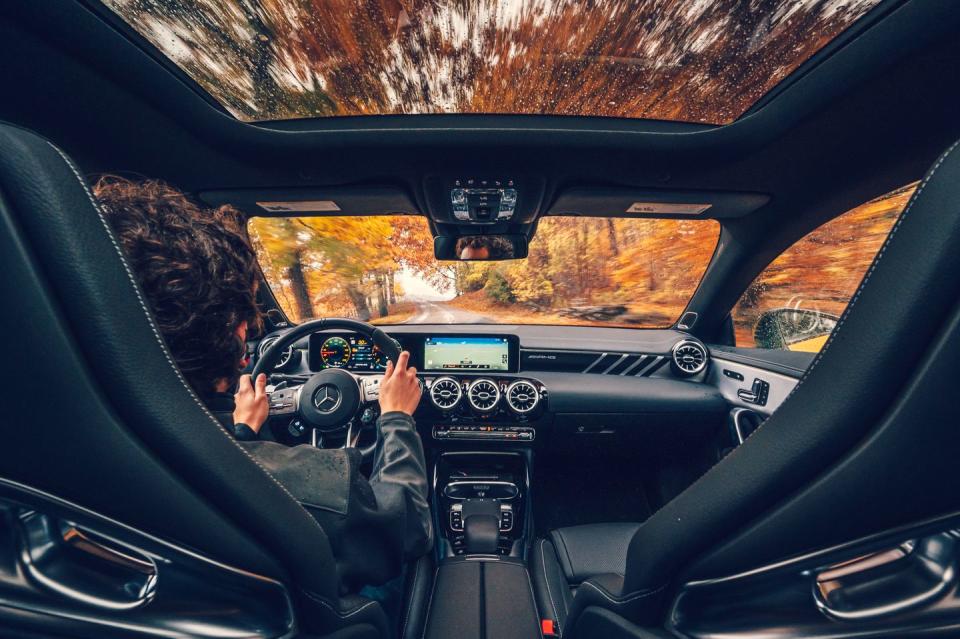
The Road
On top of everything else we’ve all dealt with, this year has presented us with a truly wild hurricane season. We’ve had so many weather events, meteorologists have run out of names, moving to the Greek alphabet to identify the latest tropical storms and hurricanes. And it just so happened that the day of our road testing coincided with the arrival of the remnants of Hurricane Zeta in the northeast.
Conditions were awful. The high temperature was 48 degrees with a 100-percent chance of heavy rain the entire day. Not exactly ideal for testing any vehicle’s back-road handling. With soaking conditions that caused standing water and low visibility, we had a lot to think about, much of which related to keeping the cars on the road instead of hydroplaning into a ditch. So we took some of the cars to Lime Rock’s tight autocross to get a sense for limit handling in safe, closed-course circumstances.
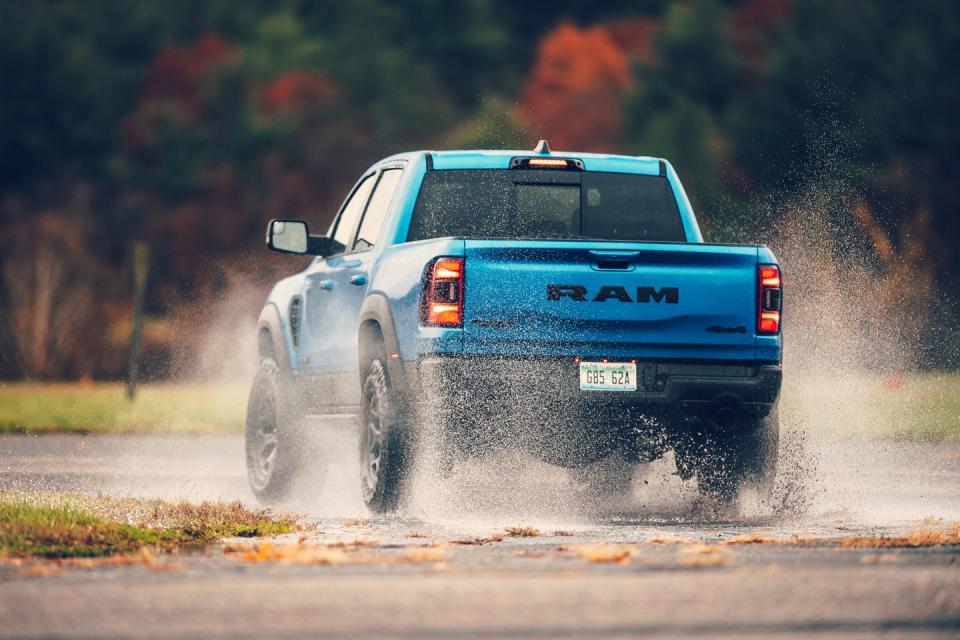
In reality, there isn’t much you can learn from most of these cars on a day like this. Bad weather played into the hands of the Ram TRX, staffers looking for puddles, mud pits, and jumps, anything to test the off-road shocks and huge horsepower. That’s the Ram’s forte, but it’s not our typical criteria when picking a country road barnstormer.
Our test included four all-wheel drive, year-round GT cars: The M8, Polestar, F-Type, and Bentley. Literally and figuratively, they floated comfortably and contently through our deluged testing day. The less-aggressive tires that hampered these cars in one way or another on track came good, providing grip and confidence under conditions where the speed limit became an actual maximum speed.
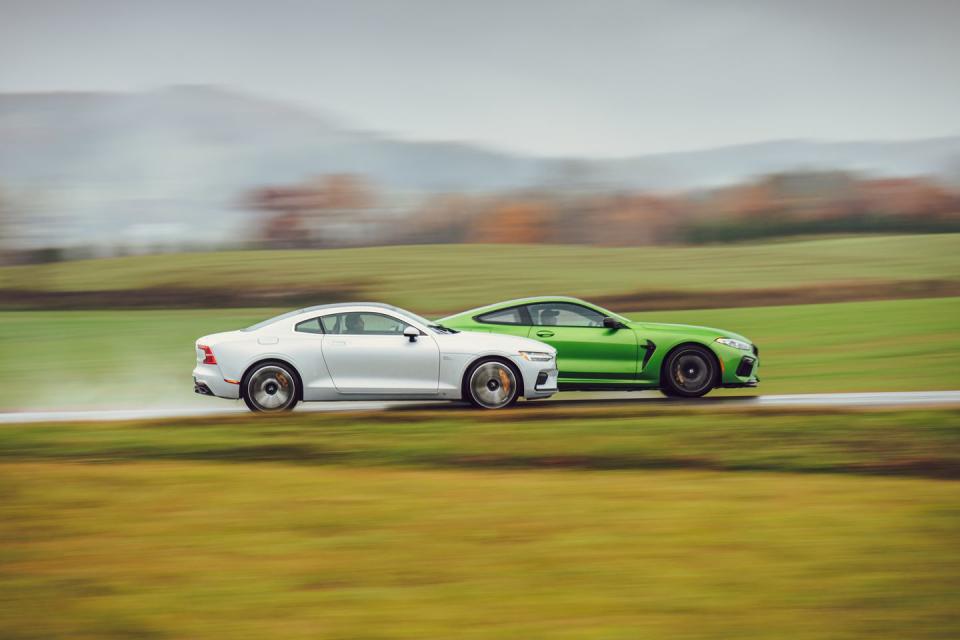
One thing that’s apparent on the road: The Polestar is gorgeous, lower and wider than you expect. But the more you stare at it, or sit in it, the more you notice its Volvo roots. That’s not a bad thing—right now, Volvo is building the most beautiful cars it’s ever made—but the parts-bin items can make the Polestar feel like a trim level, not a halo model from a new standalone brand. The interior is almost identical to what you’d find in an S90, with very little to differentiate this $156,500 car. And the Ohlins dampers, adjusted to Polestar’s recommended setting for spirited driving, made the ride too firm in the view of some editors.
The M8 and Bentley properly insulate you from the outside world, a trait that becomes even more welcome when the weather turns bad. But while the M8’s interior is interchangeable with so many BMWs on the market today, the Bentley’s feels oh-so-special, particularly the rotating infotainment screen. Of course, the most expensive car in our test should have a jaw-dropping interior. But both of these cars also wowed us on Lime Rock’s autocross course in the wet.
With the front axle disconnected, the M8 becomes lairy, though the overboosted steering makes it hard to catch once all that power overwhelms the rear tires. The Bentley, though, was shocking fun. The theater of it all, drifting your library, was hilarious. Sorokanich formed a bond with the car. “Powerful and progresive, it delights in leaning over into a long, languid drift,” he wrote.
While it was comfortable and in its element on the road, the F-Type was disappointing on the autocross. It was nearly impossible to get the front tires to hook up, meaning that most attempts at drifting ended in failure, greeted with massive understeer as the front axle fed in power.

The Cayman T, the least-powerful car in our test (by one horse), was a delight on the road, showing a wide breadth of use that extends to track days and inclement weather alike. “On these tight, wet, bumpy roads, I can’t think of a car I want to drive any more,” said Perkins of the Porsche.
The CLA45, wearing its less-aggressive factory-fit Michelin Pilot Sport 4S tires, was a charmer.
The Merc became a sudden contender with its performance on the autocross course, drift mode turning the front-biased coupe-ish sedan into a lurid little all-wheel drive slide machine. It’s unintuitive at first, but the trick is to keep a slight bit of throttle on to send power to the rear, and use less steering angle than you think you need, coaxing the baby Benz to do a convincing impression of a rally car. Our two rally fiends, Aaron Brown and Silvestro, spent tons of time sliding the AMG around the autocross, grinning like fools.
During our time on the road, one car continually came back with near universal disdain: the Mini. The aggressive setup that made it such a hoot on the track became a nightmare. Silvestro summed it up: “Really isn’t pleasant to drive on the road. Extremely stiff setup plus short wheelbase make it very bouncy on any surface. And not having a manual is a letdown.”
Mini charges dearly for the experience. At more than $45,000, you have to really want this specific car, with all its pros and cons. The bigger problem is, it’s just not as good as last year’s PCOTY winner, the Hyundai Veloster N, which costs a good $15,000 less and offers a manual gearbox.
Then there’s the Mustang. The only car here wearing nearly-slick track day tires. Fat ones at that, 305s up front, 315s out back. It was a handful on the autocross with the traction control off, as you’d expect. These tires really need a lot of heat to get in their element. But if you drive the Mustang with a delicate touch, and consider a little left-foot braking, it’ll pull off a lurid slide, that supercharged V-8 bouncing off the limiter with abandon and obliterating Lime Rock’s strict decibel limit. Sorry, neighbors.
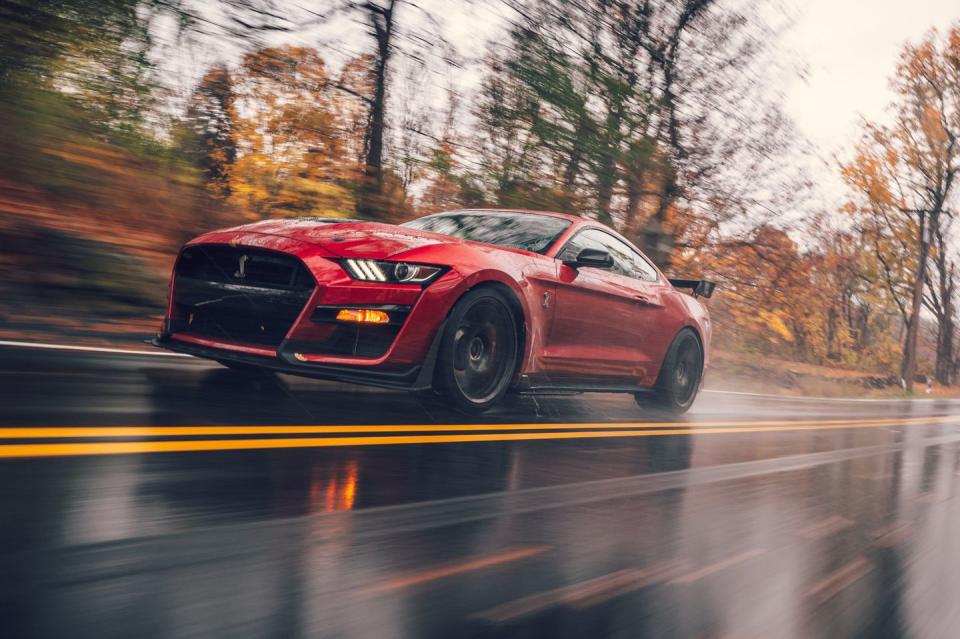
On the road, with the traction control set to “slippery” mode, the GT500 gives you just enough wheelspin to let you have some fun, shutting things down before they get out of hand. The Sport Cup 2s are acceptable in most conditions, with more wet-weather ability than you may have been led to believe. And the ride quality is fantastic—firm, yes, but not bone-crushing like the Mini or hyper-distant like the Bentley. It strikes a wonderful middle ground.
Our only on-road criticism of the GT500 had to do with its size, with some staffers feeling it would be a handful on tighter back roads. It’s also outrageously fast in the dry, meaning it could be a handful if things went wrong at extra-legal speeds. But if our experience is any judge, you don’t need to go nuts to have fun in this Shelby.

The Winner
It was the quickest vote in PCOTY history. A unanimous choice that should be obvious by now. The Ford Mustang Shelby GT500 is a true triumph, and one of the all-time great pony cars. A genre-redefining epic that brings a little Trans Am to the street and makes you feel like a hero on the track. There are so few cars like this, a willing partner thoughtfully designed and engineered to be a track rat and a back-road demon alike, an ultra-high-performance brute that’s useful in all kinds of weather. Even without our car’s optional Track Pack, the GT500 is beyond capable.
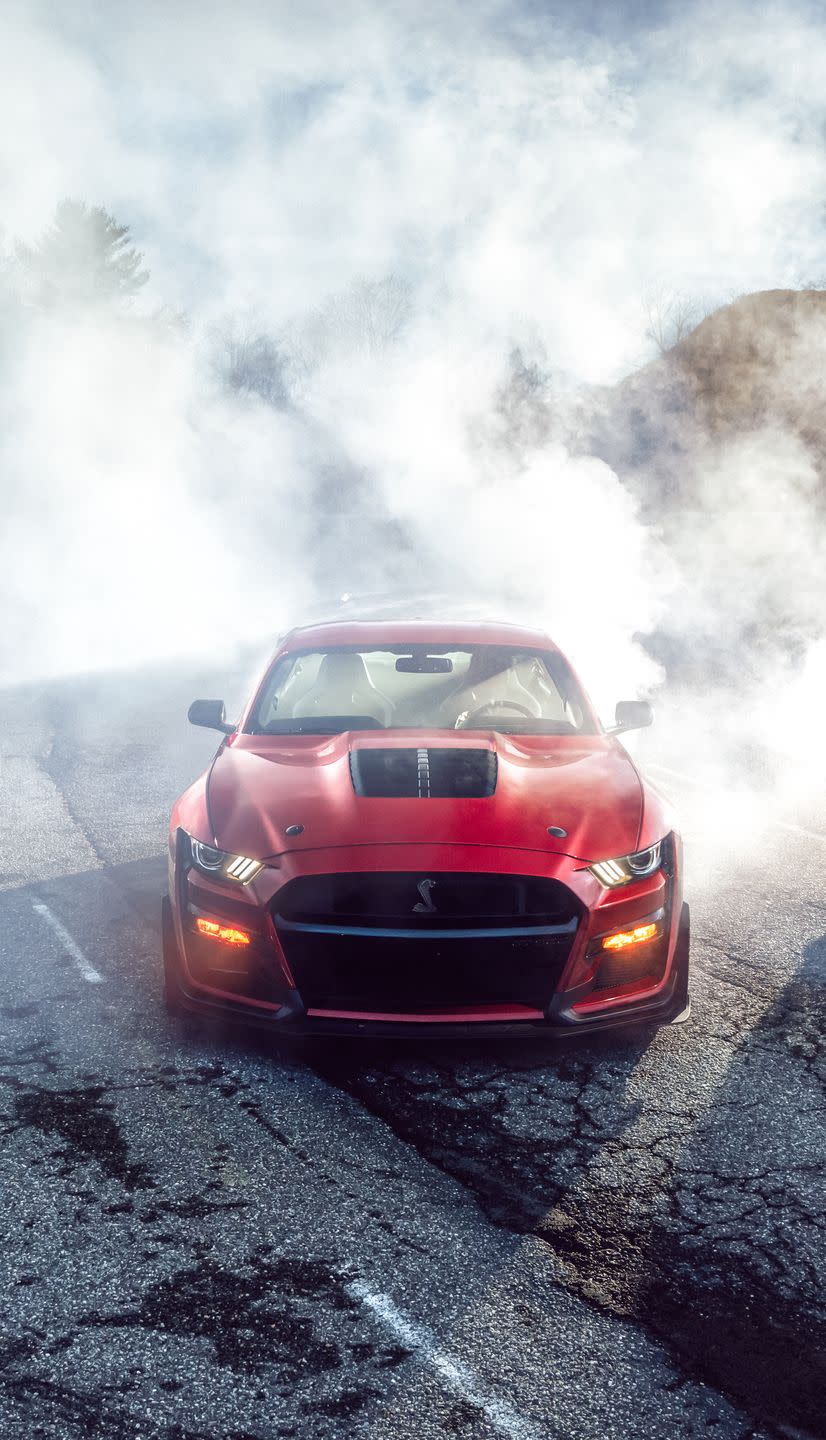
Some of you will likely view this year’s PCOTY with an asterisk. We lost three top-spot contenders before the competition even started, due to circumstances beyond our control. By all estimates, the Cayman GT4 would have been right up there—particularly since, after the dust settled, the Cayman T was a close second choice, let down only by its uncharming engine. The flat-six in the GT4 would have rectified that, and could have earned the Cayman the win. McLaren’s missing 765LT would have been right there in the mix, considering McLaren’s 720S won the title in 2018. And the Ferrari F8 has roots in the 488 Pista, a car that came extremely close to winning PCOTY just two years ago.
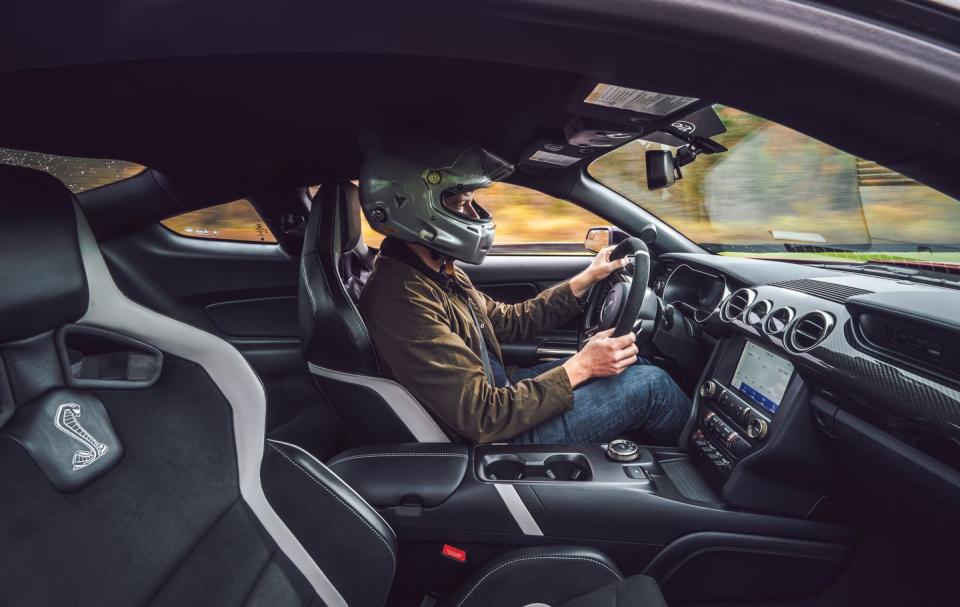
Delete that asterisk in your mind. The GT500 would have wowed us no matter what else was in the field. This car is a masterclass, proof that a team of engineers who care about performance can work miracles with a well-engineered platform. And like the Mustang GT that nearly won PCOTY in 2015, and the GT350R that did win in 2016, there is something inherently special about the whole package. It also doesn’t hurt that this GT500 was one of the less expensive cars in the test, a performance bargain that’s accessible to a much wider swath of the population than the exotics it runs neck-and-neck with.
This also marks the end of the line for this generation of Mustang. A new model is due in 2022 that will surely see turbocharged engines, hybrid drivetrains, and more big changes. Just another development in the history of America’s first pony car. But as long as Ford remembers to let the team at Ford Performance work their magic on the next Mustang, we’re in for another generation of PCOTY contenders. Bring it on.
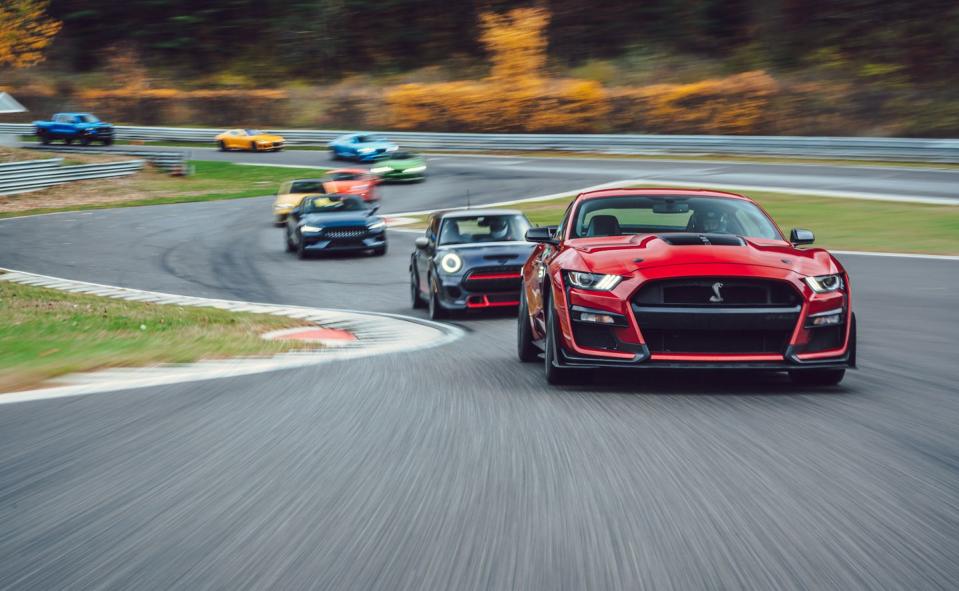

Interested in joining us behind-the-scenes at our next annual test? Join the Track Club by R&T.
You Might Also Like

 Yahoo Autos
Yahoo Autos 